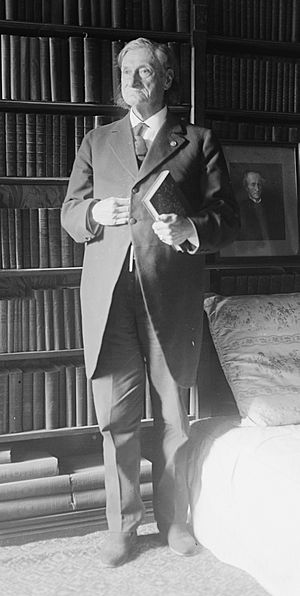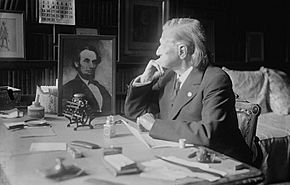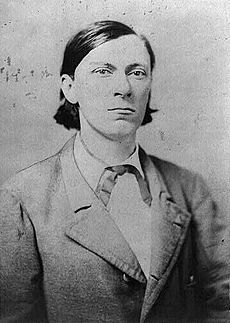Roger Atkinson Pryor facts for kids
Quick facts for kids
Roger Atkinson Pryor
|
|
|---|---|
 |
|
| Member of the Confederate States House of Representatives from Virginia | |
| In office February 18, 1862 – April 5, 1862 |
|
| Preceded by | Position established |
| Succeeded by | Charles F. Collier |
| Delegate from Virginia to the Provisional Confederate Congress | |
| In office July 20, 1861 – February 17, 1862 |
|
| Preceded by | Position established |
| Succeeded by | Position abolished |
| Member of the U.S. House of Representatives from Virginia's 4th District | |
| In office December 7, 1859 – March 3, 1861 |
|
| Preceded by | William O. Goode |
| Succeeded by | George W. Booker |
| Personal details | |
| Born | July 19, 1828 Petersburg, Virginia, U.S. |
| Died | March 14, 1919 (aged 90) New York City, New York, U.S. |
| Political party | Democratic |
| Alma mater | Hampden–Sydney College University of Virginia |
| Profession | journalist, lawyer, judge |
| Military service | |
| Allegiance | |
| Branch/service | |
| Years of service | 1862–1864 |
| Rank | |
| Unit | 3rd Virginia Cavalry Regiment |
| Commands | 3rd Virginia Infantry Regiment Florida Brigade |
| Battles/wars | American Civil War |
Roger Atkinson Pryor (born July 19, 1828 – died March 14, 1919) was a newspaper editor and politician from Virginia. He was known for his strong speeches supporting the Southern states leaving the United States, a process called secession. He served in both the U.S. government and the government of the Confederate States of America. During the American Civil War, he was a general for the Confederate Army.
After the war ended in 1865, Pryor moved to New York City to start a new life. His family joined him in 1868. He became a successful lawyer and a judge. He was also active in the Democratic Party in the North.
Contents
Early Life and Education
Roger Pryor was born near Petersburg, Virginia, at a place called Montrose. He was the second child of Lucy Atkinson and Theodorick Bland Pryor. His father was a minister. Roger had an older sister named Lucy. His family had lived in Virginia for many generations.
Pryor went to Hampden–Sydney College and graduated in 1845. He then studied law at the University of Virginia, finishing in 1848. The next year, he became a lawyer. However, he stopped practicing law for a while due to health issues. Before he got married, he started working as a journalist.
Marriage and Family
On November 8, 1848, Roger Pryor married Sara Agnes Rice. She was from Halifax County, Virginia. Sara was raised by her aunt and uncle, Mary Blair Hargrave and Dr. Samuel Pleasants Hargrave. They lived in Hanover, Virginia, and later moved to Charlottesville for Sara's education.
Roger and Sara Pryor had seven children together:
- Maria Gordon Pryor (called Gordon) (1850 - 1928). She married Henry Crenshaw Rice. Their daughter, Mary Blair Rice, became a writer known as Blair Niles.
- Theodorick Bland Pryor (1851 - 1871). He was very smart and went to Princeton College at a young age. He also studied at Cambridge University and was studying law when he died at 20.
- Roger Atkinson Pryor. He became a lawyer in New York.
- Mary Blair Pryor. She married Francis Thomas Walker.
- William Rice Pryor (born around 1860 - 1900). He became a doctor and surgeon in New York and died young.
- Lucy Atkinson Pryor. She married the architect A. Page Brown. They moved to San Francisco, California, in 1889.
- Francesca (Fanny) Theodora Bland Pryor (born December 31, 1868). She married William de Leftwich Dodge, a painter. They lived in Paris and New York.
Career and Politics
For a few years, Pryor worked as a journalist. He wrote for the Washington Union in 1852 and the Daily Richmond Enquirer in 1854. The Daily Richmond Enquirer was a very important newspaper in the South.
In 1854, President Franklin Pierce appointed Pryor as a diplomat to Greece. When he returned to Virginia in 1857, he started his own newspaper called The South in Richmond. He became well-known for speaking strongly in favor of slavery and the idea of states' rights. This meant states should have more power than the federal government. He also strongly supported secession, which was the idea that Southern states should leave the United States.
In 1859, Pryor was elected to the U.S. House of Representatives as a Democrat. He represented Virginia's 4th District. He served from December 1859 to March 1861, when Virginia left the Union. In Congress, Pryor often argued with Thaddeus Stevens, a Republican from Pennsylvania who wanted to end slavery.
Pryor once got into a big argument with John F. Potter, a representative from Wisconsin. Pryor challenged Potter to a duel. Potter chose bowie knives as the weapons. Pryor refused, saying knives were not "civilized weapons." This event was widely reported in Northern newspapers. They made Pryor look like a coward and a "fire eater" (someone who strongly supported secession and slavery).
On April 5, 1860, during a speech against slavery by Owen Lovejoy, Pryor and other Democrats became very angry. They threatened Lovejoy with harm, and other politicians had to step in to protect him.
American Civil War
In early 1861, Pryor pushed for Virginia to secede right away. In April, he went to Charleston to urge an attack on Fort Sumter. He believed this would make Virginia secede. On April 12, he was offered the chance to fire the first shot of the war, but he refused. He said, "I could not fire the first gun of the war." Pryor almost became the first casualty of the war. While visiting Fort Sumter, he mistakenly drank a bottle of potassium iodide, thinking it was whiskey. Union doctors quickly saved his life.
In 1861, Pryor was re-elected to Congress, but he never took his seat because Virginia seceded. He served in the provisional Confederate Congress in 1861 and the first regular Confederate Congress in 1862.
He joined the Confederate army as a colonel of the 3rd Virginia Infantry Regiment. He was promoted to brigadier general in April 1862. His brigade fought in the Peninsula Campaign and at the Second Manassas. His command was known as "The Florida Brigade." At the Battle of Antietam in September 1862, he took command of a division. However, his troops were flanked by Union forces and had to retreat.
Because of this, he did not get a higher command from the Confederate president. In 1863, Pryor resigned his position as general. He then joined the 3rd Virginia Cavalry Regiment as a private and scout. Pryor was captured on November 28, 1864, and held in Fort Lafayette in New York. He was released on parole by order of President Abraham Lincoln and returned to Virginia.
During the early part of the war, Sara Rice Pryor, Roger's wife, worked as a nurse for the soldiers. After Roger resigned his commission in 1863, she stayed in Petersburg and worked to keep their family together. She later wrote about her experiences during the war in her memoirs.

Life After the War
In 1865, Roger Pryor, who was now poor, moved to New York City. Friends he knew before the war had invited him. He started a law firm with Benjamin F. Butler, a former Union general who was disliked in the South. Pryor became involved in Democratic politics in New York.
In 1868, Pryor brought his family from Virginia to New York. They settled in Brooklyn Heights. They faced financial struggles for years but slowly rebuilt their lives. Pryor became known as one of the influential Southerners in the North. He eventually gave speeches saying he was glad the country was reunited and that the South had lost the war.
In 1890, Pryor was appointed as a judge of the New York Court of Common Pleas. He served there until 1894. He was then appointed as a justice of the New York Supreme Court, serving from 1894 until he retired in 1899.
In December 1890, Pryor joined the Sons of the American Revolution (SAR). This group was for men whose ancestors fought in the American Revolutionary War. Because women were not allowed to join, Sara Agnes Rice Pryor and other women started their own group, the Daughters of the American Revolution. They worked to preserve history and educate people.
After retiring, Pryor was appointed as an official referee by the state Supreme Court in 1912. He served in this role until he died on March 14, 1919, in New York City. He was buried in Princeton Cemetery in Princeton, New Jersey, alongside his wife and some of their children.
Legacy and Honors
- A highway marker in Virginia honors Pryor's birthplace near Petersburg.
Sara Agnes Rice Pryor
Sara Pryor faced many challenges when she and her husband were poor in New York. She sewed clothes for her children and helped her husband with his law studies. She also helped raise money to create a home for women and children in need.
Like her husband, Sara Pryor helped start many historical organizations. These included Preservation of the Virginia Antiquities (now Preservation Virginia), the Mary Washington Memorial Association, the Daughters of the American Revolution (DAR), and the National Society of the Colonial Dames of America.
After 1900, she became a successful writer. She published two history books about the colonial era, two memoirs, and several novels. Her book, Reminiscences of Peace and War (1904), was recommended for study by the United Daughters of the Confederacy.
See also


